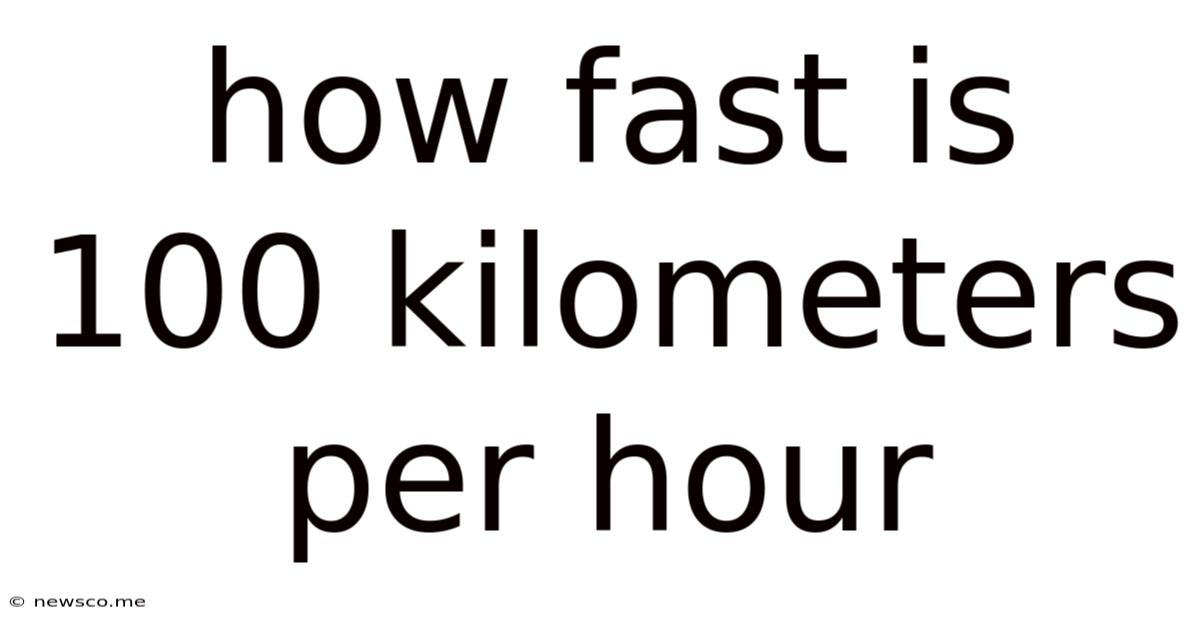How Fast Is 100 Kilometers Per Hour
News Co
Mar 29, 2025 · 5 min read

Table of Contents
How Fast Is 100 Kilometers Per Hour? A Comprehensive Exploration
100 kilometers per hour (km/h). The number itself might seem straightforward, but the actual speed it represents can be surprisingly difficult to truly grasp. Is it fast? Slow? Dangerous? The answer, as we'll explore in detail, depends heavily on context. This article will delve deep into understanding 100 km/h, comparing it to other speeds, exploring its implications in different situations, and examining the factors that influence its perceived speed.
Understanding the Speed: 100 km/h in Perspective
To truly understand 100 km/h, we need to establish a frame of reference. Let's begin by converting it to more familiar units:
-
Miles per hour (mph): 100 km/h is approximately 62 mph. This conversion helps those accustomed to the imperial system to better visualize the speed.
-
Meters per second (m/s): 100 km/h is roughly 27.8 m/s. This unit provides a more granular understanding of the speed's instantaneous change in position.
Now, let's compare 100 km/h to common everyday speeds:
-
Walking: A brisk walking pace is around 5 km/h. 100 km/h is a staggering 20 times faster.
-
Cycling: A reasonably fit cyclist might reach 20 km/h. 100 km/h is five times faster.
-
City Driving: Average city driving speeds rarely exceed 50 km/h. 100 km/h is significantly faster, doubling the speed.
-
Highway Driving: On highways and freeways, 100 km/h is often the speed limit in many parts of the world. This highlights that it's a speed considered manageable for vehicles on open roads under ideal conditions.
-
Train Travel: Many high-speed trains operate at speeds exceeding 100 km/h, illustrating that it's a relatively common speed for long-distance rail travel.
Factors Influencing the Perception of Speed
While the numerical value of 100 km/h remains constant, our perception of it can vary drastically based on several factors:
-
The vehicle: Driving a sports car at 100 km/h feels dramatically different than driving a large truck at the same speed. The acceleration, handling, and overall sensation are significantly impacted by the vehicle's characteristics.
-
The environment: Driving 100 km/h on a straight, smooth highway feels vastly different than navigating winding mountain roads at the same speed. The increased risk and required driver skill significantly alter the perceived speed.
-
The passenger's experience: Someone who frequently travels at high speeds may perceive 100 km/h as relatively slow, while someone unfamiliar with such speeds might find it quite fast. Experience shapes our perception of risk and speed.
-
The presence of obstacles: The presence of other vehicles, pedestrians, or unexpected hazards drastically increases the perceived danger of driving at 100 km/h. The potential for accidents significantly impacts the perception.
100 km/h in Different Contexts
The implications of 100 km/h differ widely depending on the context:
Driving
-
Safety: At 100 km/h, the stopping distance is significantly longer than at lower speeds. This necessitates increased following distances and greater vigilance to avoid accidents. A collision at this speed can have devastating consequences.
-
Fuel efficiency: Fuel consumption generally increases at higher speeds. Maintaining 100 km/h consistently can lead to reduced fuel economy compared to driving at slower speeds.
-
Legal implications: Driving 100 km/h in areas with lower speed limits can result in significant fines and penalties. Understanding and adhering to speed limits is crucial for safe and legal driving.
Air Travel
In the context of air travel, 100 km/h is remarkably slow. Commercial airliners typically cruise at speeds exceeding 800 km/h. This speed difference highlights the vast difference in speed between ground and air transportation.
Train Travel
Many high-speed rail networks operate at speeds exceeding 100 km/h. This speed is often considered comfortable and efficient for long-distance travel.
Other Modes of Transportation
Compared to other modes of transportation, such as boats or bicycles, 100 km/h represents a remarkably high speed. This emphasizes the speed advantage of motorized vehicles.
The Importance of Context and Safety
Ultimately, understanding how fast 100 km/h is requires considering the context. While numerically it's a specific speed, its perception and implications are highly dependent on the situation. Safe driving practices, awareness of surroundings, and adherence to speed limits are crucial for mitigating the risks associated with driving at this speed or any speed for that matter. Remember that speed limits are designed to enhance safety, and exceeding them greatly increases the potential for accidents. Always prioritize safe driving practices regardless of the speed.
Beyond the Numbers: The Human Factor
While we've focused on the quantitative aspects of 100 km/h, it's crucial to acknowledge the human element. Our perception, reaction time, and decision-making abilities all play a vital role in how we experience and manage this speed. Factors like fatigue, stress, and distraction significantly impact our driving performance and the safety implications of driving at 100 km/h. Staying alert, focused, and well-rested is crucial for safe driving at any speed.
Conclusion: A Speed with Many Faces
100 kilometers per hour is more than just a number; it's a speed with diverse implications depending on the context. It's a speed that can feel relatively slow on a high-speed train or incredibly fast when navigating a busy city street. Understanding the relative speed in different scenarios, acknowledging the environmental factors, and prioritizing safety are crucial to navigating the world at this speed and beyond. Responsible driving practices, constant vigilance, and awareness of one's limitations are paramount for safe and effective transportation at all speeds. Remember that even a seemingly manageable speed like 100 km/h can be dangerous if not approached with responsibility and caution.
Latest Posts
Related Post
Thank you for visiting our website which covers about How Fast Is 100 Kilometers Per Hour . We hope the information provided has been useful to you. Feel free to contact us if you have any questions or need further assistance. See you next time and don't miss to bookmark.